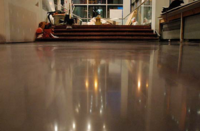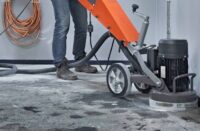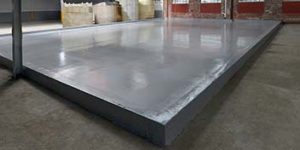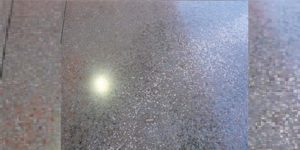
All things in polished concrete relate to physics and chemistry. With that in mind, let’s look at moisture effects on polished concrete and polishing chemicals, with an additional focus on efflorescence.
Measure moisture in concrete as a moisture vapor emission rate, or MVER, and as in situ relative humidity, or RH. Just as concrete density and porosity affect the absorption of densifier and colorants, the porosity of a slab will also affect MVER and RH readings. The moisture level in turn can affect the vibrancy and staying power of topical color, the penetration of densifier, the clarity of shine, the strength development of concrete, and the appearance (differential cure marks) and level of efflorescence.
Dye trouble
Topically applied dyes penetrate the concrete surface but do not chemically bond to reactive elements in the concrete. Many of you have experienced topical-color shifts of intensity on some jobs. The reason is often related to barometric pressure and vapor drive changes that occur when acclimatizing the building.
Clients may reasonably wonder what the weather or the air conditioning can possibly have to do with the intensity or longevity of the color of their concrete floor. The answer is moisture and pH.
The development of the pH scale we use is for aqueous solutions of acids and bases. One only measures alkalinity in the presence of moisture. As we are all well aware, concrete is alkaline (9-10.5 pH).
Moisture and alkalinity levels can combine to create the perfect storm of conditions that can affect topically applied color. Dyes and colorants offer ease of use and produce beautiful installations, but we must understand the risks that come along with them. MVER will fluctuate and could diminish or dissolve color from the surface. When the interior air pressure and RH levels fall below those in the concrete slab, vapor drive from the slab increases until it equalizes.
Concrete dye is unstable in an alkaline environment. Product data sheets typically require MVER prior to application of less than 5 pounds per 1,000 square feet per 24 hours. When the alkaline moisture rises through the concrete pores, it can dissolve a portion of the dye and carry the color in solution to the surface. In turn, a simple cleaning of the floor can wipe the color away.
Densifier issues
Moisture also affects the amount of densifier that will penetrate the slab. Common job-site conditions include high humidity, low airflow and cold temperatures. All of these variables will reduce densifier absorption. A proactive solution is to condition the building earlier in the construction schedule using dehumidifiers, fans and heaters, along with sealing off penetrations from the outside elements. These actions allow for drier air and lower RH in situ, resulting in increased densifier absorption. Controlling the environmental conditions delivers a more absorbent slab yielding greater penetration of densifier. This leads to denser, harder, abrasion-resistant concrete that polishes up with higher clarity and shine.
Most polishers apply a stain-resistant microfilm guard or sealer, and moisture can affect this product as well. All matter breathes (has a permeability rating), including metals, plastics, glass and even concrete sealers. In the case of microfilm products, the more they plug the pores and completely cover the surface, the less permeability it has. Additionally, the more likely it will water-whiten when MVER is high or when puddles are left on the surface.
Also, many water-based materials in contact with water try to go back to original solution. (The chemistry determines the amount of time it will take.) And, as we all know, water-based products in our buckets are white! The level of haze or white ultimately depends upon the severity of the MVER and the chemistry of the product.
Efflorescence
Moisture can also lead to efflorescence, which is the discoloration of concrete caused by the accumulation of whitish salts at the surface. The Portland Cement Association explains that a combination of three factors causes efflorescence:
- Soluble salts in the concrete
- Moisture dissolving these salts
- Vapor transmission or hydrostatic pressure that moves the salts to the surface
Excess free lime or calcium hydroxide is a major source of efflorescence. Calcium hydroxide dissolves in water and comes to the surface. Here it reacts with carbon dioxide in the air to form calcium carbonate, or white chalk.
Efflorescence can develop under the “guard coat,” a rubber walk-off mat on the surface of the concrete. Visualize this by thinking of a steam room. Steam rises as a vapor, hits the ceiling and condenses into liquid, and water droplets fall. The film-forming guard is like the ceiling, and moisture and salts will condense underneath it. When the liquid evaporates, the efflorescence is trapped below. The perm rating of a specific stain protection or mat affects whether the discoloration will be below or on the surface of the concrete.
Efflorescence is mostly harmless from a structural point of view and may develop months after the project’s completion. Once a building is conditioned, relative humidity, airflow and temperature become controlled. Most of the time, the conditioning process happens at a slow enough pace that it goes unnoticed. A buildup of efflorescence will not normally develop.
Customer expectations
On occasions when efflorescence develops, the client may take some comfort from knowing that the efflorescence will stop at some point, as the amount of excess salts are finite. You can point out before the project commences that efflorescence issues will end sooner on a closed slab (vapor barrier underneath the concrete) because the only source for moisture is the water of convenience from the original concrete pour. Once the excess salts have been brought to the surface and the slab RH has equalized to the air, the efflorescence will stop. Unfortunately, however, if the vapor barrier was compromised or missing, equilibrium may never be established. It is a waiting game until the excess salts disappear.
An exterior of a brick building provides an example of efflorescence ending. A new brick or block building will often have vertical white lines running down the wall, originating at the mortar. The difference between the efflorescence on a new brick wall and the lack of it on an older brick wall is simply time. I have personally found that this example effectively calms the waters with a client surprised by the development of efflorescence. After you’ve explained it, it is a situation that you can help your customer deal with, not a problem you caused.
When you return to clean and burnish such a floor, use the visit to reinforce your relationship with your client. Even these delicate situations can be educational opportunities and solidify your relationship with your clients.
Chemistry and physics are ultimately in control. As contractors, we must test and educate project owners, architects and general contractors so they understand how and why this occurs. Once educated, the construction team can be proactive instead of reactive, and this is better for all involved.
Questions from readers
Question
I have a landscaping issue that promotes water intrusion into a concrete slab home. I am told this situation is not permanently fixable due to the unfixable slope of the grade. Are polished concrete floors an option with periodic water intrusion?
Answer from Concrete Decor
Thanks for your inquiry. Just so you know, your house isn’t the only one out there with this kind of problem.
First of all, we encourage you to get a few expert eyeballs on your situation. There are instances when Mother Nature just can’t seem to find another path of least resistance. In other words, underground water flow will rise to the surface at some point even if it’s under someone’s house.
Not knowing much about your location and the geography around your residence we can tell you that there are remedies, they just may not be all that inexpensive. One solution we have come across includes cutting a hole in the concrete, digging down to below the water table and installing a sump pump. The sump activates each time a rising water level triggers its float valve. Some people even store that water extraction for gardening, etc.
There are a couple of companies out there like Terra Firma and Ram Jack that may have dealt with these kinds of problems in your area so do reach out to them. You may also consider contacting a local architect who can point you to an engineer specialized in these kinds of problems.















